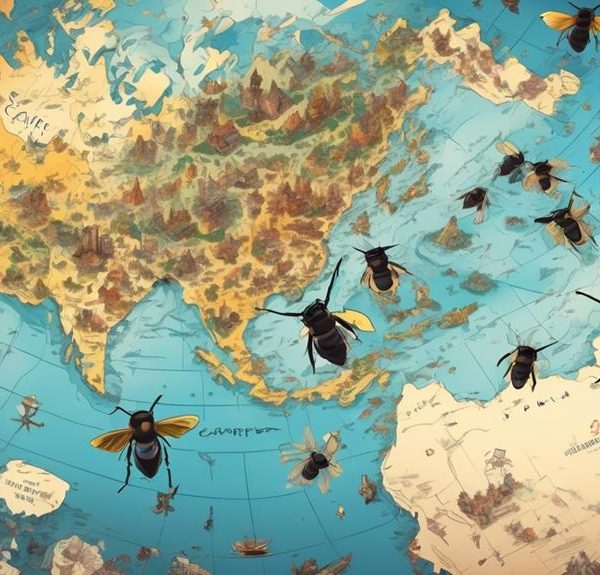Sail' through the fascinating journey of how bees buzzed their way to America, a tale of ecological adaptions and surprising human interventions.

How Did Bees Come to America?
Imagine the gentle hum of bees buzzing among flowers, their tiny bodies dusted with golden pollen as they labor in the heart of summer.
You're likely familiar with these industrious insects, but have you ever pondered on how they came to inhabit the vast landscapes of America?
The journey of bees to this land is a fascinating tale, steeped in ecological adaptations, geographical shifts, and even human interventions.
While we're just scratching the surface here, wouldn't it be intriguing to explore the route these tiny travelers took to reach the place we call home today?
Key Takeaways
- Bees have a long history dating back over 100 million years, with the first honey bees appearing around 45 million years ago.
- Bees likely migrated to North America from Africa through Europe and Asia, possibly crossing the Bering Land Bridge around 14 million years ago.
- Bees play a crucial role in American ecosystems as essential pollinators, contributing to the growth and genetic diversity of plants.
- The decline of bees would have significant impacts on crop production and the food chain, as one third of the food consumed relies on pollination by bees.
Origins of Bees: A Brief History
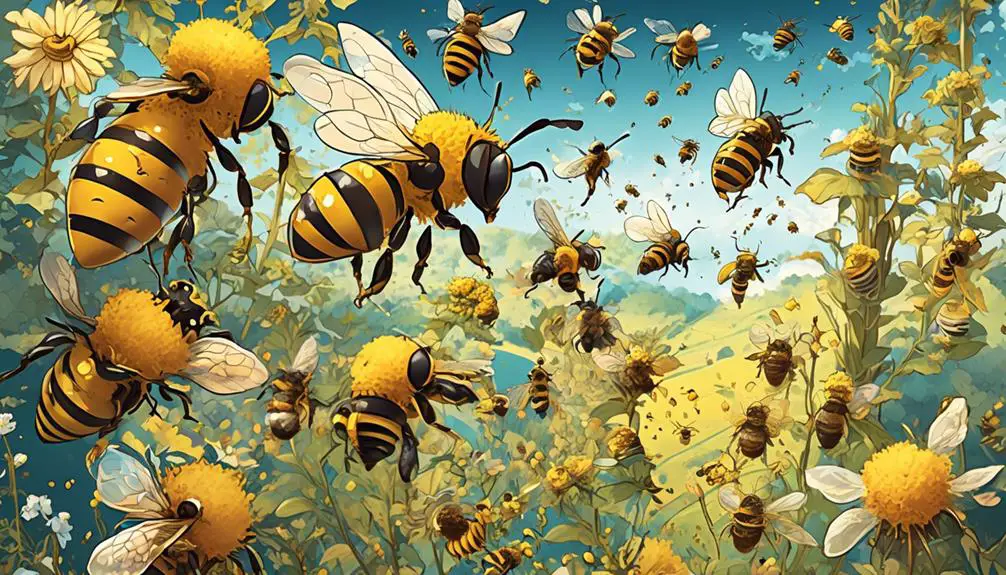
Surprisingly, bees have a history dating back to the Cretaceous period, when the first flowering plants began to appear. These industrious insects were already pollinating plants over 100 million years ago. Can you imagine? That's around the same time dinosaurs roamed the earth!
Now, let's take you back in time. You're in the Eocene epoch, about 45 million years ago, when bees began to evolve into the numerous species we know today. You'd witness the first appearance of honey bees, some of whom would eventually migrate to North America.
Fast forward to the Pleistocene epoch, about 2.6 million years ago. You're seeing the first bumblebees, which evolved in cooler climates. They're the ones that perfected the 'buzz pollination' technique, where they vibrate their flight muscles to dislodge pollen. Genius, isn't it?
The history of bees is intertwined with the history of flowering plants. You can't discuss one without mentioning the other. As you've seen, bees have been around for quite some time, contributing to the biodiversity and beauty of our world. So next time you see a bee, remember, you're looking at an ancient creature with a rich history.
Bees' Migration Route to America
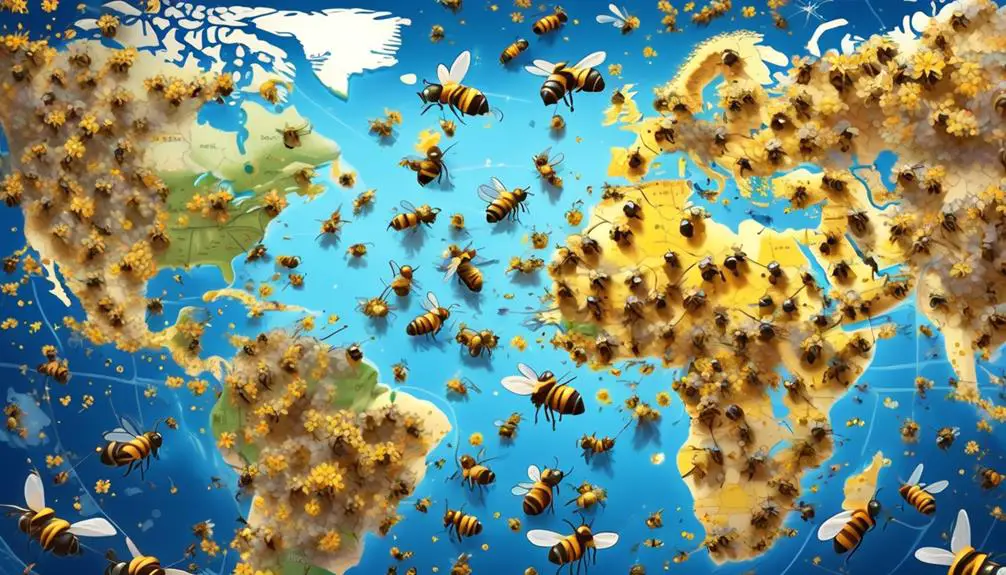
Now that we've explored their ancient origins, let's trace the journey of bees as they made their way to the Americas. It's widely believed that bees migrated from Africa to Europe, then to Asia and finally North America. This grand journey took place over millions of years, driven by changes in climate and the spread of flowering plants.
Around 14 million years ago, bees started their migration to North America. They likely traversed the Bering Land Bridge, which connected Asia to Alaska. This bridge existed during periods of glaciation when sea levels dropped, unveiling a pathway for various species to migrate.
Once they reached North America, bees diversified and adapted to different climates and ecosystems, from the arid deserts of the southwest to the lush forests of the northeast. They even made their way to South America, possibly via land bridges or island hopping.
Despite these migrations, it wasn't until European settlers arrived that honey bees, as we know them, made their debut in America. They were introduced for honey production and as pollinators for crops. So, while bees have a long history in the Americas, the bees you're probably most familiar with have a relatively recent, human-aided arrival story.
Impact of Bees on American Ecosystems
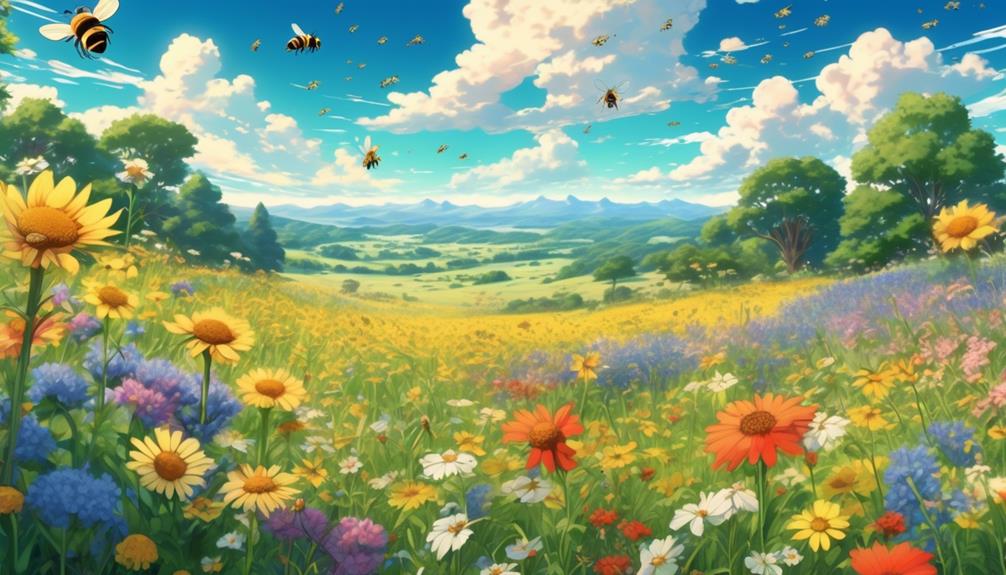
You'd be amazed at the profound impact bees have had on the ecosystems throughout the Americas. These industrious creatures are essential pollinators, responsible for aiding the growth of a vast majority of our plants. They've become the cornerstone of thriving ecosystems, from the lush forests of the Pacific Northwest to the grassy plains of the Midwest, and even the tropical climates of Central and South America.
Without bees, many plant species would struggle to reproduce. This, in turn, would affect the diet of herbivorous animals, disrupting the entire food chain. Their pollination efforts also contribute to the genetic diversity of plants, making ecosystems more resilient to threats like disease and climate change.
Bees are remarkably efficient pollinators, and their decline would significantly impact the production of crops that we rely on for food, like fruits, nuts, and vegetables. It's estimated that one third of the food that we consume each day relies on pollination mainly by bees.
Cultural Significance of Bees in America
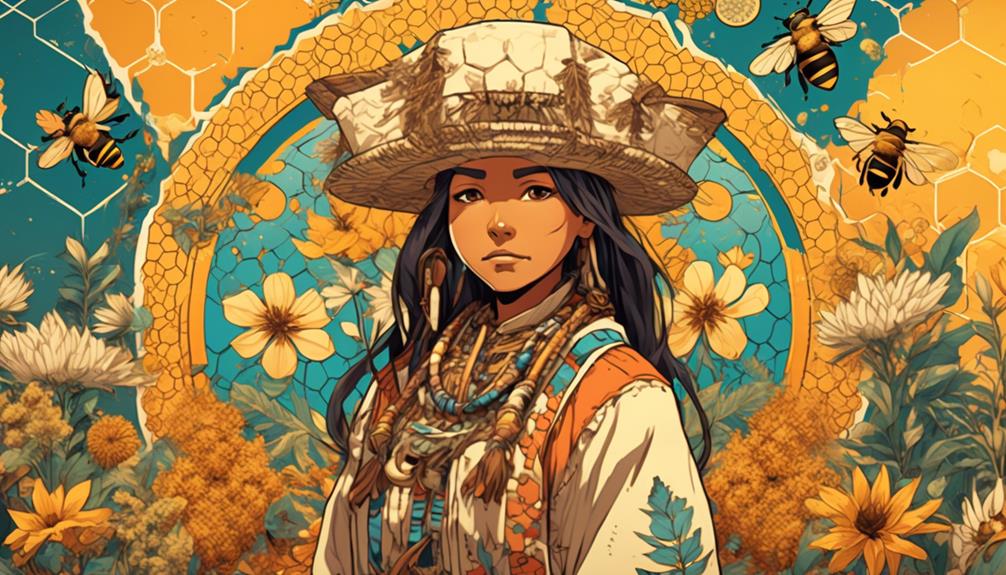
Beyond their ecological contributions, bees hold a deep cultural significance in America. They are woven into the fabric of various indigenous beliefs, folk tales, and even modern day practices. For many Native American tribes, bees symbolize community, brightness, and personal power. They've been depicted in indigenous art and folklore, their industrious nature often used as a metaphor for human society.
In the realm of agriculture, bees have been revered for their crucial role in pollination. This has led to the popular saying: 'No bees, no food.' American farmers have long understood the value of these tireless workers, often incorporating bee motifs into their farm signage as a mark of respect and recognition.
In modern times, you can see the influence of bees in American pop culture. The phrase 'busy as a bee' has been adopted into everyday language, symbolizing hard work and diligence. Bees have also become a favorite subject in children's literature, with characters like Maya the Bee and Winnie the Pooh's love for honey showcasing their endearing qualities.
In a broader context, bees have come to symbolize environmental health, prompting nationwide conservation efforts. Their cultural importance continues to grow, reflecting America's evolving understanding of these extraordinary insects.
Bees' Contribution to the American Economy
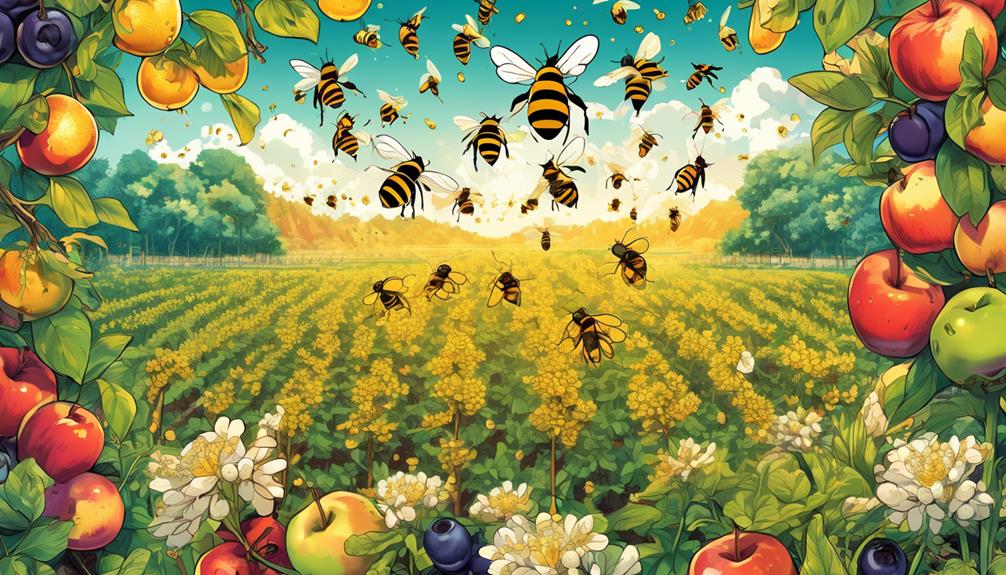
In the realm of economics, bees make a remarkable contribution to the American economy, with their pollination services estimated to be worth billions of dollars annually. You may not realize it, but every time a bee lands on a flower, it's not just collecting nectar. It's also performing a service that's vital to the health of the agricultural industry.
Honey bees and wild bees are the primary pollinators of many of the crops grown in the United States. Your favorite fruits, vegetables, and nuts, such as apples, almonds, and berries, rely heavily on bee pollination. Without these tiny workers, you'd see a significant decrease in the yield and quality of these foods.
Here's a simple breakdown:
Crop | Annual Value of Bee Pollination |
|---|---|
Apples | $2.5 billion |
Almonds | $11.7 billion |
Berries | $1.9 billion |
Frequently Asked Questions
What Are the Different Species of Bees That Exist in America?
You'll find a diverse range of bee species in America. There're over 4,000 species including the well-known Honeybee and Bumblebee.
You'll also encounter Carpenter bees, Sweat bees, and Leafcutter bees. Some of the lesser-known species include the Mining bee, Mason bee, and the Blueberry bee.
Each species plays a crucial role in pollination, contributing to the growth and diversity of flora in their respective habitats.
How Do Bees Communicate With Each Other in the Hive?
Bees communicate using a series of movements known as the 'waggle dance.' When a worker bee finds a good source of food, it'll return to the hive and perform this dance to share the location with others. The direction and duration of the dance indicate the direction and distance to the food source.
It's a complex language, isn't it? It's how bees ensure the entire colony gets the information they need to survive and thrive.
What Are the Common Threats to Bees' Survival in America?
You're likely aware that bees face numerous threats to their survival in America. Pesticides, habitat loss, climate change, and disease are prime culprits. When farmers spray crops with harmful chemicals, bees ingest these and it can lead to death.
Urbanization shrinks their natural habitats, while abnormal weather patterns disrupt their life cycles. Plus, parasites and diseases can spread rapidly in a hive, causing mass casualties.
It's a tough world for these crucial pollinators.
How Does Climate Change Affect the Population of Bees in America?
Climate change affects bee populations in America in several ways. It disrupts their hibernation cycles, throws off their foraging patterns, and reduces the diversity of their food sources.
You've probably noticed more erratic weather patterns like early springs or late winters. These changes can directly impact bees, leading to population declines.
It's a complex issue, but that's the gist of how climate change threatens America's bees.
What Measures Are Being Taken to Protect Bees in America?
You're probably wondering what's being done to protect bees in America.
Various measures are being implemented. Many organizations promote the planting of bee-friendly flowers and reducing pesticide use.
There's also legislation like the Save America's Pollinators Act, aiming to protect bees from harmful substances.
On a local level, some cities have even become 'bee cities', committing to creating sustainable habitats for bees.
Conclusion
So, you see, bees didn't originate in America. They journeyed here, dramatically altering ecosystems and cultural practices.
Their impact isn't just historical; today, they're vital for our economy, especially in agriculture. Understanding the bees' journey to America helps us appreciate their significance and highlights the need for their conservation.
After all, without bees, our landscapes and livelihoods would look very different.

